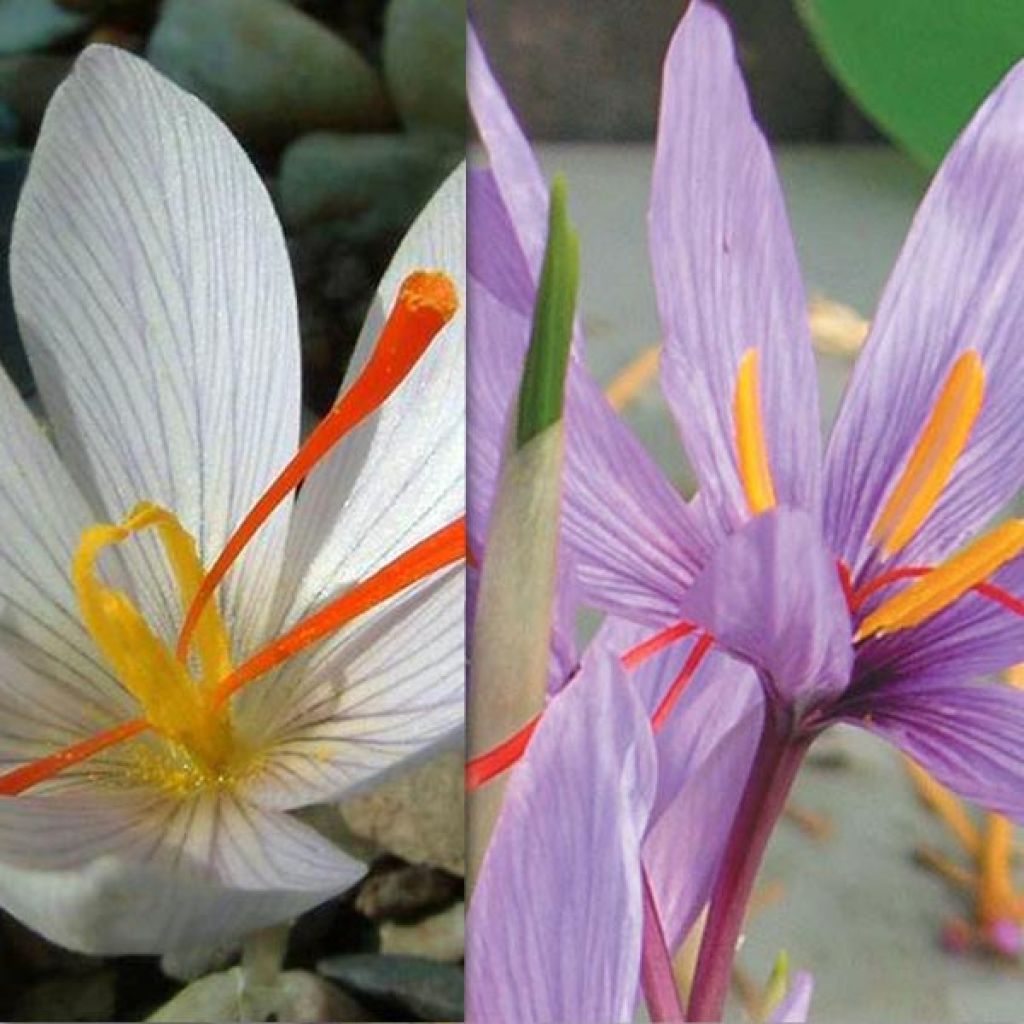

Saffron Collection
Saffron Collection
Crocus sativus
Autumn Crocus, Saffron Crocus
The bulbs arrived in perfect condition. I planted them. The flowers gave me beautiful saffron, just like in Spain, in the village where saffron has been cultivated by families for generations... ????
Philippe , 20/03/2024
This plant carries a 6 months recovery warranty
More information
We guarantee the quality of our plants for a full growing cycle, and will replace at our expense any plant that fails to recover under normal climatic and planting conditions.
From €5.90 for pickup delivery and €6.90 for home delivery
Express home delivery from €8.90.

Does this plant fit my garden?
Set up your Plantfit profile →
Collection items (34 plants)
Description
We present a Saffron Collection of 34 Saffron Bulbs (Latin name Crocus sativus), whose flowers will be purple or white depending on the plants. If you harvest your own saffron, the red-orange filaments that so beautifully enhance their crocus flowers will add a characteristic flavour and colour to your cooking. The saffron crocus is planted in summer, during its dormant period, and is easily grown in full sun, in a very well-drained, light soil that is preferably kept dry in summer. Hardiness: -15 °C (5 °F) or below.
The collection consists of:
14 White Saffron Crocuses in size 6+ (a lovely variety with white flowers)
20 Crocus sativus in size 8+ (the type species)
Individually labelled.
Crocus sativus is a perennial geophyte plant (having an underground storage organ) of the Iridaceae family. It is a sterile plant, not producing viable seeds, probably resulting from the hybridisation of two wild crocuses, which appeared several thousand years ago somewhere in Greece or Turkey according to specialists. The saffron crocus has a corm (swollen base of the stem) that allows it to go into a dormant state in summer, thus escaping summer drought. Its foliage consists of 6 to 10 very thin dark green linear leaves, 15 to 20 cm (6 to 8 in) long, which are a little leathery and bordered by cilia. It develops in autumn, persists throughout winter and disappears in early summer. Flowering usually takes place in October, before the appearance of foliage, at the same time or just after. The large, spectacular 10 cm (4 in) flowers emerge directly from the ground. They are very beautiful, formed by a corolla with 6 petals, the centre of which is occupied by 3 stamens with anthers covered in yellow pollen and 3 long red filaments called stigmas, harvested and dried to be used in cooking as a spice or colouring agent. The petals are mauve veined with purple in the type species, while the white variety has white petals veined with purple. Unlike most crocus species, these flowers remain open even in the dark.
Crocus sativus can be used in the vegetable garden, of course, but also in an ornamental garden, as it is as decorative as it is useful. It can be planted in beds, borders, rockeries, or even in pots for autumn crocuses. In the garden, it can be planted along the edge of a bed or in a rockery, always in full sun and in well-drained, light soil, and can be associated with pretty perennial ground covers for dry soil: Artemisia lanata, wild thyme, Phyla nodiflora, or Cerastostigma plumbaginoides with its red foliage in autumn, and many others. Tall ornamental garlics like Allium christophii, as well as Scilla peruviana, Amaryllis belladonna, Sternbergia lutea, or other bulbs that appreciate dry summer soils, will also make good companions for saffron crocuses.
Mainly produced in Iran, saffron is harvested every day from the flowers (the flowers have a short life of about 48 hours), ideally at sunrise to preserve its taste qualities. Once harvested, the stigmas are dried: let them dry for about twenty minutes in a slightly warm oven (60 °C (140 °F)) and then store them in airtight containers. It takes 150 flowers to produce one gram of saffron.
We include an explanatory note on how to harvest saffron with your saffron crocuses. We also offer saffron crocuses for sale. Wholesale prices on request.
Report an error about the product description
Plant habit
Flowering
Foliage
Botanical data
Crocus
sativus
Iridaceae
Autumn Crocus, Saffron Crocus
Mediterranean
Planting and care
Plant your saffron crocuses before 20 September (ideally from the end of June or in July), during their summer rest period: they will flower the same autumn! Plant your bulbs in a warm, south or west-facing position, 15 cm (6 in) deep and spaced 8 cm (3 in) apart. They prefer sunlight and well-drained soil that has been previously deeply worked and is light, permeable and enriched. Sandy or clay-limestone soil that is not too wet will be perfect. If your garden soil is too heavy, incorporate sand and gravel when planting. The first cold weather will make their flowers appear.
Leave them in place for several years to obtain beautiful flowers without any special care. The bulbs can be divided every summer to increase production. This crocus prefers to be grown in groups. To obtain the saffron, cut the "saffron stigmas" from your crocus when each flower blooms, ideally at sunrise to preserve their taste quality, and let them dry for about twenty minutes in a slightly warm oven (60 °C (140 °F)): and there you have your saffron!
Planting period
Intended location
Care
-
, onOrder confirmed
Reply from on Promesse de fleurs
Haven't found what you were looking for?
Hardiness is the lowest winter temperature a plant can endure without suffering serious damage or even dying. However, hardiness is affected by location (a sheltered area, such as a patio), protection (winter cover) and soil type (hardiness is improved by well-drained soil).

Photo Sharing Terms & Conditions
In order to encourage gardeners to interact and share their experiences, Promesse de fleurs offers various media enabling content to be uploaded onto its Site - in particular via the ‘Photo sharing’ module.
The User agrees to refrain from:
- Posting any content that is illegal, prejudicial, insulting, racist, inciteful to hatred, revisionist, contrary to public decency, that infringes on privacy or on the privacy rights of third parties, in particular the publicity rights of persons and goods, intellectual property rights, or the right to privacy.
- Submitting content on behalf of a third party;
- Impersonate the identity of a third party and/or publish any personal information about a third party;
In general, the User undertakes to refrain from any unethical behaviour.
All Content (in particular text, comments, files, images, photos, videos, creative works, etc.), which may be subject to property or intellectual property rights, image or other private rights, shall remain the property of the User, subject to the limited rights granted by the terms of the licence granted by Promesse de fleurs as stated below. Users are at liberty to publish or not to publish such Content on the Site, notably via the ‘Photo Sharing’ facility, and accept that this Content shall be made public and freely accessible, notably on the Internet.
Users further acknowledge, undertake to have ,and guarantee that they hold all necessary rights and permissions to publish such material on the Site, in particular with regard to the legislation in force pertaining to any privacy, property, intellectual property, image, or contractual rights, or rights of any other nature. By publishing such Content on the Site, Users acknowledge accepting full liability as publishers of the Content within the meaning of the law, and grant Promesse de fleurs, free of charge, an inclusive, worldwide licence for the said Content for the entire duration of its publication, including all reproduction, representation, up/downloading, displaying, performing, transmission, and storage rights.
Users also grant permission for their name to be linked to the Content and accept that this link may not always be made available.
By engaging in posting material, Users consent to their Content becoming automatically accessible on the Internet, in particular on other sites and/or blogs and/or web pages of the Promesse de fleurs site, including in particular social pages and the Promesse de fleurs catalogue.
Users may secure the removal of entrusted content free of charge by issuing a simple request via our contact form.
The flowering period indicated on our website applies to countries and regions located in USDA zone 8 (France, the United Kingdom, Ireland, the Netherlands, etc.)
It will vary according to where you live:
- In zones 9 to 10 (Italy, Spain, Greece, etc.), flowering will occur about 2 to 4 weeks earlier.
- In zones 6 to 7 (Germany, Poland, Slovenia, and lower mountainous regions), flowering will be delayed by 2 to 3 weeks.
- In zone 5 (Central Europe, Scandinavia), blooming will be delayed by 3 to 5 weeks.
In temperate climates, pruning of spring-flowering shrubs (forsythia, spireas, etc.) should be done just after flowering.
Pruning of summer-flowering shrubs (Indian Lilac, Perovskia, etc.) can be done in winter or spring.
In cold regions as well as with frost-sensitive plants, avoid pruning too early when severe frosts may still occur.
The planting period indicated on our website applies to countries and regions located in USDA zone 8 (France, United Kingdom, Ireland, Netherlands).
It will vary according to where you live:
- In Mediterranean zones (Marseille, Madrid, Milan, etc.), autumn and winter are the best planting periods.
- In continental zones (Strasbourg, Munich, Vienna, etc.), delay planting by 2 to 3 weeks in spring and bring it forward by 2 to 4 weeks in autumn.
- In mountainous regions (the Alps, Pyrenees, Carpathians, etc.), it is best to plant in late spring (May-June) or late summer (August-September).
The harvesting period indicated on our website applies to countries and regions in USDA zone 8 (France, England, Ireland, the Netherlands).
In colder areas (Scandinavia, Poland, Austria...) fruit and vegetable harvests are likely to be delayed by 3-4 weeks.
In warmer areas (Italy, Spain, Greece, etc.), harvesting will probably take place earlier, depending on weather conditions.
The sowing periods indicated on our website apply to countries and regions within USDA Zone 8 (France, UK, Ireland, Netherlands).
In colder areas (Scandinavia, Poland, Austria...), delay any outdoor sowing by 3-4 weeks, or sow under glass.
In warmer climes (Italy, Spain, Greece, etc.), bring outdoor sowing forward by a few weeks.





































